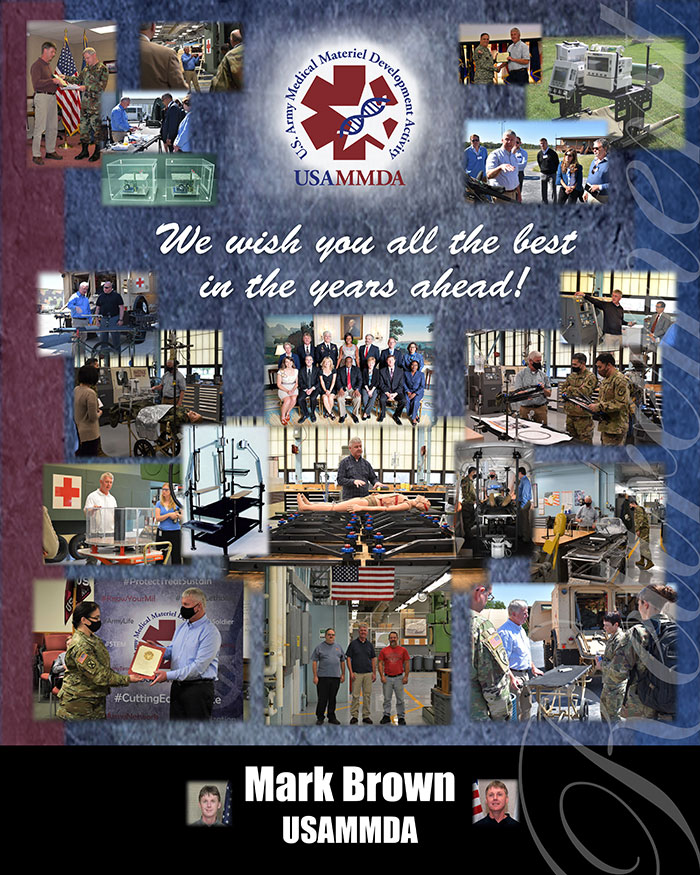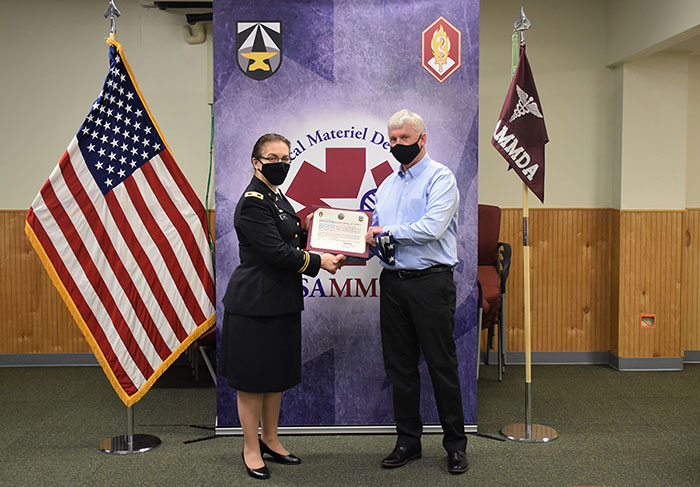USAMMDA Says Farewell to Mark Brown after 37 Years of Civilian Service

After nearly four decades of federal civilian service, a valued member of the U.S. Army Medical Materiel Development Activity retired at the end of February. As an experienced mechanical engineer, Mark Brown served as supervisor of USAMMDA's Medical Prototype Development Laboratory at Fort Detrick. In this role, Brown may have held one of the most interesting jobs on post, tasked with managing a diverse range of high-tech projects from concept to completion. Under the direction of USAMMDA's Warfighter Health, Performance and Evacuation Project Management Office, Brown's MPDL team has helped to create numerous medical products and devices intended to save and support America's Warfighters throughout the world.
"The lab is made up of an integrated team of engineering technicians that work together to design, develop drawing packages, and rapidly prototype far-forward medical equipment in support of the U.S. Army Medical Research and Development Command's mission," explained Brown. "We focus on facility and equipment planning to ensure our highly skilled workforce has the resources it needs to complete the given assignment."
Over the years, Brown has helped to ensure his team's capability of rapidly prototyping medical devices in a wide range of scales and variety of materials. Further, his group has worked together to harden commercial-off-the-shelf components, equipment, and products for use in the field environment. Brown takes great pride in his team's collective contribution to a multitude of innovative products, some of which have been granted U.S. patents. These include far-forward medical devices as well as specialized test apparatus used by our nation's premier research laboratories. For the latter, the devices and products were designed specifically to adhere to unique requirements that cannot be obtained through items from the commercial market. Much of Brown's work over the years has centered on developing products that aid in the research and treatment of traumatic brain injury – which serves to highlight his faithful dedication to the health and welfare of our military men and women.
Having been with USAMMDA for the past 30 years, Brown feels he has been blessed to live and work in Maryland's Frederick County his entire life – and he certainly appreciates being so close to home. But as he recalls, his career began a bit further down the road.
"I started my civilian career at the Carderock Division of the Naval Surface Warfare Center (formerly David W. Taylor Naval Ship Research and Development Center) in April 1985," he said. "After about two years of commuting to the Washington, DC, area, I was fortunate enough to find a job closer to home, at the U.S. Army Biomedical Research and Development Laboratory, which was headquartered here at Fort Detrick."

"I worked with the USABRDL until 1992, when the facility was closed and the group I worked for (now known as the WHPE PMO) was transferred to USAMMDA," he continued. "I've been here ever since then. In total, I feel honored to have accumulated 37 years as a civilian, serving 30 of these years here at USAMMDA."
As a teenager, Brown continually was interested in working on anything of a mechanical nature, and working with all types of tools, both powered and manual. He enjoyed fixing things, and trying to understand how and why these things worked. Clearly, the machinist and mechanical engineering genes were instilled early on within Brown, and he remembers how he developed his education in the field, while growing up in the area around Fort Detrick.
"I was born and raised here in Frederick, the youngest of four children," said Brown. "My educational path was somewhat unconventional, as I didn't pursue college immediately after high school. However, the Frederick County Public School system offered a technical path at their (then) newly built Frederick County Career and Technology Center, better known as the CTC. During my time there, my desire to become a journeyman machinist really took hold of me."
"After graduating high school, including three years of study at the CTC, I started my first full-time job at Frederick Manufacturing Company, as an apprentice machinist," he continued. "During my employment there, I completed the State of Maryland's four-year apprenticeship program to become a journeyman machinist. Later in my career, I attended college in the evenings, to pursue my interest in engineering."
Needless to say, Brown's dedication and perseverance eventually paid off – in spades. After earning an Associate of Science degree in engineering from Frederick Community College, he then transferred to Johns Hopkins University in Baltimore, where he obtained a Bachelor of Science degree in mechanical engineering – all the while working at his full-time position.
For those who know Brown, his success is not surprising. He is always on the positive side of an equation. In the simplest of terms, he is someone who helps makes things happen – and this is most evident when he relates receiving a team award that he describes as a pinnacle in his career.
As part of USAMMDA's Medical Support Systems Project Management Office, Brown served as an integral member of the project team that developed the CASEVAC kit, which is a casualty evacuation package that facilitates the rapid conversion of a wide range of non-ambulance vehicles into medical evacuation vehicles in less than one minute. Neatly stored in the back of the vehicle, the CASEVAC kit's contents are used in transporting patients to life-saving treatment as well as for point-of-care first aid.
As a critical product that helped to save lives during both Operation Iraqi Freedom and Operation Enduring Freedom, the CASEVAC kit was heralded as significantly innovative, and the team that developed the kit was awarded the 2010 Samuel J. Heyman Service to America Medal in the category of Safety, Security and International Affairs. Brown remains extremely proud to have been a part of this nine-member group, which was recognized for outstanding achievement during an awards recognition ceremony at the White House.
Typical of Brown, he always has preferred to work as part of a team – there is no "me" in "Brown" – and he always makes a point to praise his colleagues whenever possible.
"There are so many people I'd like to thank and acknowledge, but at the risk of leaving out anyone, I will just say I feel extremely blessed to have been associated with such a vast array of professionals. This includes leaders who took an interest in me personally, supporting my endeavors whenever they could – promoting, encouraging and helping me through both the high points and the challenging times of life."
"And I'm so thankful to have experienced the support of my co-workers on a daily basis, while working as a team through a myriad of projects. In the end, my career has been enriched with so many people I now consider true friends."
Army Col. Gina E. Adam, USAMMDA commander, has worked with Brown for many years, and she appreciates his long-standing dedication to the organization's critical mission.
"Mark Brown is one of those quiet professionals whose dedication and consistency can constantly be relied upon," said Adam. "I believe he is one of those people that everyone knows to call. With his many accomplishments over the years, I can only imagine how often people called him to ask whether an idea was feasible and what ideas he might have to improve a product or design. His work has truly had an impact on battlefield medicine."
As he begins his new life in retirement, Brown plans on finishing a list of home improvement projects, while also scheduling some time for fishing and hiking in the open air of the Maryland countryside. Along with these activities, however, he said he is truly looking forward to spending more time with his family and friends, and dedicating some quiet time to learning more of God's scripture while enjoying His blessings – which certainly includes his wife, Tammy.
"I've been very happily married to my wonderful wife for nearly 40 years, and she is my inspiration," he said. "We have two beautiful daughters, both of whom are married, and we are blessed with four grandchildren. Now I will be able to spend much more time with all of them."
For many, Brown's retirement may be the definition of bittersweet. His USAMMDA teammates certainly wish him well with regard to this new chapter of his life, but the same group will be saddened by his departure. For nearly forty years, Mark Brown has been a "constant" to many: a constant ideal employee, a constant ideal co-worker, a constant ideal friend – always looking to build up others around him from a very sincere place in his heart.
"After all these years, I would like to end my career by saying thanks to all who make up this great workforce we call Fort Detrick – it truly has been a privilege and an honor to be associated with such an incredibly creative and professional team. I'll miss everyone."
You will be missed, too, dear friend. Continue to enjoy the blessings you've been given.













